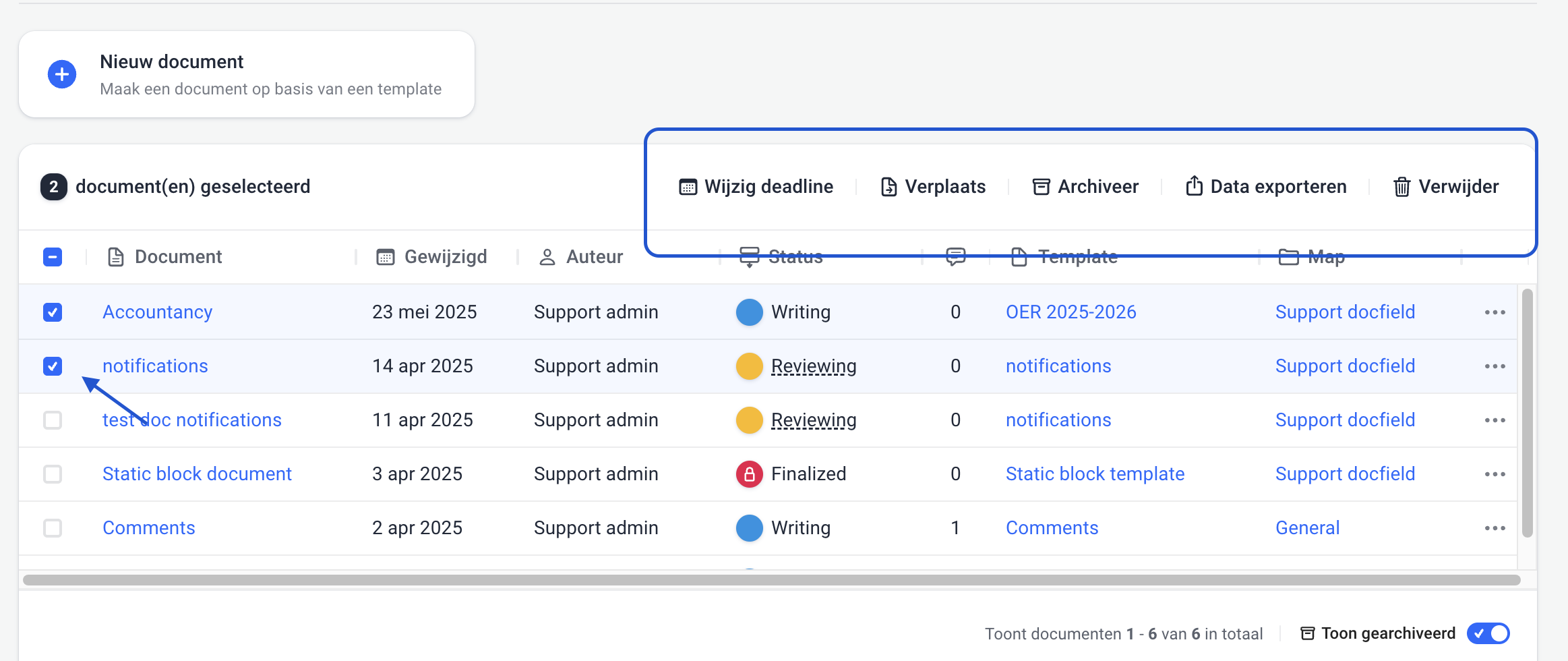With the Document Overview, you as a user or owner gain more control over how you view documents and their data within Docfield. This new feature displays documents in a clear table format, where you can immediately see key information such as status, author, deadlines, and more. You no longer need to open documents individually to gain insights. Thanks to filtering, sorting, and search options, you can find what you need more quickly and perform actions efficiently. Owners can fully customize the view and save it as the default for their team, while users can easily make use of the available filters and sorting options.

In this manual
Navigating the Document ViewThe document view displays a list of documents in a table. You can:
Batch Actions (Multi-Select)By selecting multiple documents, you can perform actions such as:
- Columns That Are Always VisibleThese columns are mandatory and cannot be hidden:
- Sorting
- Filtering by Columns
Navigating the Document View
The document view displays a list of documents in a table. You can:
Scroll horizontally to see all columns
Click on documents to open them
Drag columns to change their order
Select multiple documents at once for batch actions
Batch Actions (Multi-Select)
By selecting multiple documents, you can perform actions such as:
Changing the deadline
Moving to another folder
Archiving
Exporting data
Deleting

Roles & Permissions
Depending on your role in Docfield, owner or user you have different permissions when it comes to adjusting the view. The table below shows who can do what. Owners have full control and can save changes as the default view for all users within their environment. Users can sort, filter, and adjust columns for their own session, but these settings are not saved after refreshing the page.
| Function | Owner | User |
|---|---|---|
| Show/Hide Columns | ✅ Yes, and Save | ✅ Yes |
| Adjust Column Order | ✅ Yes, and Save | ✅ Yes |
| Sort | ✅ Yes, and Save | ✅ Yes |
| Filter | ✅ Yes, can't be saved | ✅ Yes |
⚠ Users can sort, filter, and adjust columns, but their settings are not saved after refreshing the page.
Manage Columns
As an owner, you have extensive control over which columns are visible, their order, and their width.
| Column | Visible | Filterable |
|---|---|---|
| Document name | Mandatory | ✅ |
| Author | ✅ | ✅ |
| Status | ✅ | ✅ |
| Workflow deadline | ✅ | ✅ |
| Expiration date | ✅ | ✅ |
| Global Smartfields | ✅ | ✅ |
| Language | ✅ | ✅ |
| Comments | ✅ | ❌ |
| Template | Mandatory | ✅ |
| Folder | Mandatory | ✅ |
| Progress | ✅ | ❌ |
You can sort by all columns:
Click on a column header to sort (ascending or descending)
Only one column can be sorted at a time
Only owners can save sorting settings
Users lose their sorting after refreshing the page
You can also pin a column to the left or right side of the table, so it remains visible while scrolling horizontally.

Filtering by Columns
Click on a column header to open filter options. The available filter types depend on the column type:
| Column type | Filter options |
|---|---|
| Text | Free Text Input ("contains...") |
| Dropdown | Single or Multiple Selections (Multi-Select) |
| Date | Before, After, or On a Specific Date |
| Number | Greater Than, Less Than, or Equal To |
For dropdowns, the following applies:
- Only values that occur in documents are available as filters.
- For example: only workflow statuses that are used can be filtered.
Automatic and Global Smart Fields in Columns
In Dynamic Document Data Views, you can also see columns based on automatic smart fields and global smart fields. These fields can be sorted and filtered just like other columns, depending on their type (text, number, date).
- Automatic smart fields are fields that are filled in automatically. Examples include the creation date of a document or, in the case of educational institutions, the name of the academy.
- Global smart fields are standard fields used throughout your entire organization, such as contract value, customer name, or project number. If this information is present in the document, the field is automatically recognized and shown as a column in the overview. Learn more about how to create Global smart fields in this article.
Setting the Default View (Owners Only)
As an owner, you can save your customized column view as the default view for all users within your environment. This default view will then be applied to all folders.
Setting a Default View:
Go to a folder with documents
Click on “Manage Columns”
Choose which columns you want to display
Drag columns into the desired order
Adjust column widths if needed
Sort if desired
Click “Save for Everyone” to save the view as default
Sharing or Saving Your View
Filters and sorting you apply are automatically included in the URL. This allows you to:
Return to a filtered view (via a bookmark) when you save the URL
Share the filtered URL with colleagues
Use the back button without losing filters
⚠ Limitations for Users
Users can filter, sort, and adjust columns.
However, these changes are not saved when the page is refreshed.
Only owners can save settings as the default for a folder.
Was dit artikel nuttig?
Dat is fantastisch!
Hartelijk dank voor uw beoordeling
Sorry dat we u niet konden helpen
Hartelijk dank voor uw beoordeling
Feedback verzonden
We stellen uw moeite op prijs en zullen proberen het artikel te verbeteren